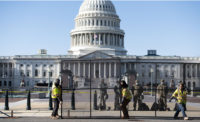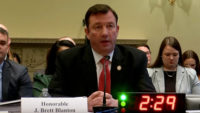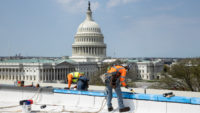With the Jan. 6 deadly riot at the U.S. Capitol still fresh in lawmakers' minds, Architect of the Capitol J. Brett Blanton told a House committee he supports "targeted" fencing in areas of the Capitol complex that are found to be most vulnerable.
Appearing at a March 11 House Appropriations subcommittee hearing on the fiscal 2022 budget for the Architect of the Capitol operation, Blanton explained and defended his request to increase it by $67 million, or 8%, to $865 million.
The request includes more than $78 million for deferred maintenance and almost $90 million for projects to renew or improve aging infrastructure, such as the Capitol's fire alarm system, campus intrusion, environmental systems and electrical distribution.
Perhaps the most frightening disclosure at the virtual hearing dealt with Blanton's $6.8-million request to update what he called the Capitol's "hodgepodge" fire-suppression system. He painted the picture of a potentially catastrophic tinderbox during the assault on Capitol Hill.
"To me, that was one of the scariest things once the breach happened." said Blanton. "If somebody decided that they were going to light something on fire, what would we have been able to do to get the people out, as well as prevent the facilities from burning down?”
Blanton also told the subcommittee that a lack of “financial support” for required COVID-19 mitigation measures throughout the Capitol campus has forced his office to dip into funds for critical infrastructure and security projects. Instead, Blanton has shifted funds to cover the cost of “enhanced cleaning” and personal protective equipment.
Fenced Out
Blanton also testified that maintaining temporary fencing guarding the complex since the breach costs $1.2 million per week.
But he noted that officials have been decreasing the fence line “in small increments.” He added that the his office is working with the US Dept. of Defense and US Capitol Police to shrink it “as much as possible and allow as much access [to the Capitol] as possible.”
Some officials, including Yogananda D. Pittman, acting Capitol Police chief, have called for permanent fencing around the Capitol. But Blanton’s security philosophy seems to be more in line with a congressional security review led by retired US Army Lt. Gen. Russel L. Honoré.
Honoré’s task force on March 8 recommended deploying mobile fencing around the complex, among other security measures, to maintain access to the nation’s most visible symbol of democracy.
Blanton told the committee that permanently fencing the entire complex would be “very, very expensive,” while installing “targeted fencing" in locations where his office can add fencing when needed, "would have less of an up-front cost.”
He said he would “prioritize” targeted fencing “so we could start getting information to Congress earlier, rather than waiting for the whole thing to be done and say, 'Here’s things we can do.' ”
In response to Subcommittee Chairman Tim Ryan (D-Ohio) on how much a permanent fence solution would cost, Blanton said he “hates to be wishy-washy” but added that the cost depends on several variables, including how much area the fence will cover.
He also said long-term costs depend on where the fence would be stored, how it would be transported, erected and broken down, and what its maintenance expenses would be. “Those are all things that we want to look at,” Blanton said. “When I look at these projects, I look at the total ownership cost; so we'll look at it over a span of time.”
Ryan said, “Well, we’re going to be asking for some help figuring out what the costs are, [the] different kinds of technology with the fences and the movable ones and all the rest.” He added, “We’re going to be leaning on you for some help trying to figure that out.”
Blanton said his operation is working with the US Army Corps of Engineers on a comprehensive security assessment that incorporates “all the other studies that are out there and make sure that we can build it into one cohesive executable strategy.”
More immediately, Blanton said design of security vestibules for the Capitol's North and South entrances will begin in April. Those checkpoints are in addition to the $600-million Capitol Visitor Center, which opened in 2008.
That underground facility was designed so that almost everyone who enters the Capitol complex does so from a security checkpoint located about a football field length away from the building itself.
Deferred Maintenance
Blanton also told the subcommittee he is planning two legislative proposals to address how projects are funded. One would allow the Architect of the Capitol to use public-private partnerships. The other would authorize enhanced-use leases to lease underutilized property under the operation’s purview to private contractors to build such things as solar farms.
To start chipping away at a long-term $1.8-billion deferred-maintenance backlog, Blanton wants to develop an Enterprise Asset Management to help operate, maintain and renew facilities and infrastructure assets. The Architect of the Capitol oversees more than 18.4 million sq ft of facilities, 570 acres of grounds and thousands of works of art, according to its website.
As an example of deferred maintenance, Blanton told lawmakers that work to fix inoperable gates to the Rayburn House Office Building parking garage did not start until after the Jan. 6 Capitol breach.
“I’m grateful that the mob didn’t know that there’s major areas of entrances [that] didn’t work,” Rep. Jaime Herrera Beutler (R-Wash.) told Blanton.






Post a comment to this article
Report Abusive Comment